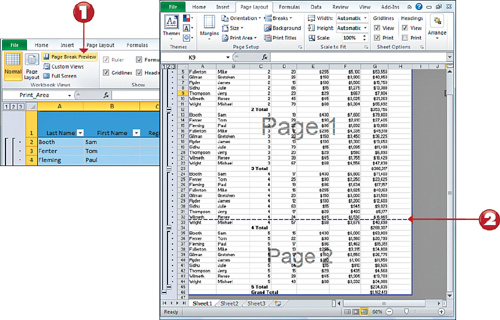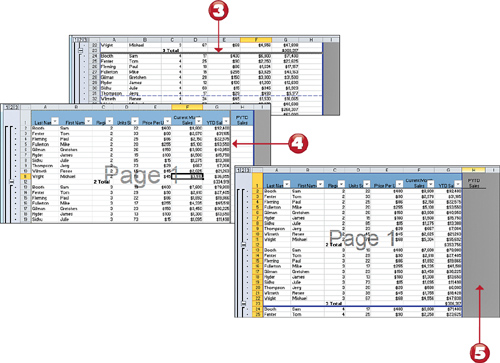Working in Page Break Preview Mode
Page Break Preview mode displays the area you have
selected for your set print area. It also enables you to click and drag
where your page breaks are instead of using the Insert, Page Break
command. You can also edit the text and data just as you can in Normal
view.

1. Click Page Break Preview from the View tab on the ribbon. If a print area has been set, it is displayed; if not, the entire worksheet is displayed.
2.
Move through the worksheet to find page breaks (if any). Naturally
occurring page breaks appear as blue dashed lines, and inserted page
breaks appear as solid blue lines.
Note: Clearing the Print Area
If you
need to set only the print area to print a portion of data in your
worksheet once, you probably want to clear the print area after you
print. Go to the Page Layout tab, click the Print Area command, and
select Clear Print Area. |

3.
To move a page break that is poorly placed, click and drag it to a
better location. (Moving a natural page break changes it to an inserted
break—solid-blue.)
4. To exclude a column or data to the right of your set print area, click and drag the vertical page break.
5. The excluded column outside the print area is grayed out.
Tip: Removing a Page Break
To
remove a page break in Page Break Preview mode, click and drag the page
break line off to the right/left/top/bottom of the worksheet. |
Printing a Worksheet on One Page
By
default, Excel prints your worksheet at a scale of 100%. You can
decrease this percentage if you want to fit more data on a page, or
increase it to fit less data on a page. In addition, you can have Excel
fit your entire worksheet on one page. (If your worksheet is large, the
data might become too tiny to read when scaled down.)

1. Go the File tab and click Print.
2. Click the Zoom and Scaling drop-down.
3. Select the Fit Sheet on One Page option.
4. Your worksheet appears in Print Preview mode, all on one page.
Tip: Changing from Letter to Legal
To
choose a different paper size for your printout, click the Paper Size
dropdown on the Print pane of the Backstage View. There, you can select
Legal. The scaling setting automatically adjusts to the selected paper
size. |
Note: Returning to the Default Scale
When
you want to return the preview of your worksheet to the default scale,
return the Scaling dropdown to the No Scaling option. |